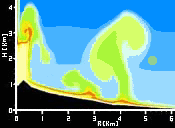
PD Dr. Ulrich Knittel:
Vulkanismus.de
Buchbesprechung
| zurück zur Startseite |
| Virtuelle Vorlesung zum Thema Vulkanismus |
| Entstehung von Magma |
| Mount Saint Helens |
| Homepage Taal (Philippinen) |
| Steffeln-Kopf (Westeifel) |
| Buchbesprechungen |

von Robert B. Smith and Lee J. Siegel
Oxford University Press
Euro 22,99 at Amazon.de
ISBN 0-19-510797-1
Order the book!
-> German review
The best known of all supervolcanoes, of course, is Yellowstone Volcano. This area is also known for its spectacula geothermal phenomena and as the first national park of the US (and worldwide). This book explains the geologic history of the area and the mechanisms at work.
The book starts with an account of the Hebgen-Lake earthquake in order to make clear from the start; this is a 'land of scenery and violence' (title of the first chapter). There follows a short summary of the geological forces at work in the Yellowstone and Grand Teton areas.
The second chapter provides an explanation of the Yellowstone hot-spot and hot-spots in general. Chapters on the eruption of the Yellowstone caldera and other calderas, now buried below the basalts of the Snake River plains and the geothermal phenomena follow. A detailed chapter explains the origin of the Teton Mountain chain. The final chapters are devoted to the glaciations during the ice ages that shaped much of the landscape and to future risks in the area (earthquakes, volcanic eruptions).
The book concludes with a proposal for a 3-day fieldtrip into the area described. 1 day is devoted to the Grand Teton park, 2 days to Yellowstone, thus providing the reader the opportunity to experience the facts for himself in the field!
The facts are largely presented in a clear and understandable way. There are, however numerous repetitions in chapters 2 and 3 that may confuse (or annoy) the attentive reader ("didn't I read that before?"). Also some terms may be confusing, why, for example, do the authors always refer to 'iron-rich basalt' (whereas a cursory search of relevant literature reveals that the Yellowstone basalts are not particularly iron-rich). Likewise, the mechanism of mantle melting is not explained in an understandable way. In particular, 'decompressional melting' is not a heat source! This is regrettable, because the processes are in general terms well understood and rarely explained in books for laymen - the earth's mantle melts upon pressure release because the temperature at which melting starts is lower at low pressures than at high pressures, hence hot rising mantle will ultimately reach a point, where its temperature correspond to its melting temperature.
The photos and maps are generally excellent, whereas the drawings of the eruptions in Figs. 3.4 and 3.5 are not really useful. Since the book is aimed at the non-specialist a sketch explaining the fault geometry during extension would be useful. In addition, I would have liked to see a photo of the ignimbrite sheets, both in field aspect and at close range.
The explanation of volcanism of Jupiter's moon Europa (p. 31) is not really correct. If the decay of radioactive elements was the only heat source, magmatic activity would be extinct since long. In really, tidal forces are at work, though at a lower level than on volcanically active moon Io. And I hope it is a mere typo, when the authors claim on p.69 that 'the pull of Earth's gravity is 30 percent below normal on the Yellowstone Plateau'. If this were true, surely Yellowstone would be the place to produce world records in athletics!!
All in all, an interesting book despite some shortcomings. For those visiting the area, the field-guide will be a useful companion.
Dr. Ulrich Knittel